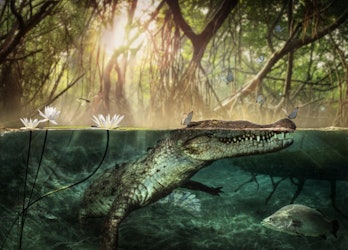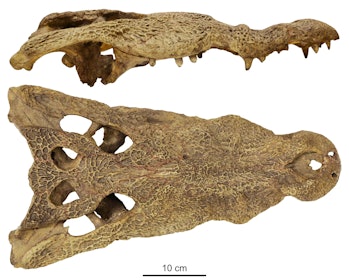Millions of years ago, crocodiles in Africa set out on a wild journey across the Atlantic Ocean. They landed in South America and gave way to a new lineage of prehistoric crocs.
That's the main takeaway of a new study describing a seven million-year-old crocodile skull discovered in Libya. Paleontologists conducted CT scans on the fossilized crania and determined that the ancient species is very similar to American crocodiles still living today. This match hints at a transatlantic journey to South America.
The findings were published Thursday in the journal Scientific Reports. It argues that the archaic species in question, Crocodylus checchiai, is a link between Nile crocodiles and four species of American crocs.
Lead study author Massimo Delfino is a paleontologist at the University of Turin who specializes in birds and reptiles. He says that the new analysis of C. checchiai places it right in between African and American species.
Because the oldest American crocodile species is about 5 million years old, discovered in Venezuela, these Libyan fossils fill a gap between two reptilian worlds. After finishing the journey, the crocodiles eventually evolved into the species we know today, spreading across the Americas, the study suggests.
"We found a species that could reasonably be the origin of the American crocodiles," Delfino tells Inverse.
TRANSATLANTIC VOYAGE — Beyond connecting these moments in crocodile evolution, the new finding suggests a geographical bridge: At some point, crocodiles like C. checchiai figured out how to go make it from Africa to the Americas.
Seafaring crocodiles might sound surprising, especially when traveling such a distance. But Delfino points out that modern marine crocodiles can travel hundreds of miles in just a month. Special glands help them excrete excess saltwater, just like the ancient species in the genus Crocodylus.

Plus, this isn't the first time researchers have theorized that ancient animals made such a trek. Researchers believe that 30 million years ago, monkeys made the same journey, with the help of rafts made of vegetation. A study published in April found that two lineages of monkeys from Africa gave way to New World monkeys in South America. That means monkeys somehow rafted over twice.
"If you think that the monkey can cross the Atlantic ocean, very probably it's much easier to accept that the crocodile can do it," Delfino says.
Today, there are four living species of true crocodiles in the Americas. Evidently, "the colonizers of America found the land warm enough to survive and to diversity," Delfino says.
"IF YOU THINK THAT THE MONKEY CAN CROSS THE ATLANTIC OCEAN, VERY PROBABLY IT'S MUCH EASIER TO ACCEPT THAT THE CROCODILE CAN DO IT."
Given what we know about marine crocodiles, it may have only taken the crocs a few months to make the trip. Marine crocodiles are also known to eat marine turtles, providing another clue as to how the ancient crocodiles fed themselves while sailing the Atlantic.
OLD BONES — While the discovery of this species as a bridge between continents and species is new, the fossilized bones were first turned up in 1938.

For nearly a century, ancient crocodile skull fossils lay in wait, most recently housed at the University Museum of Earth Sciences of Sapienza in Rome.
"This fossil is twice-old," Delfino says: It has existed for millions of years, and has also been known to humans for decades.
The fact that this "forgotten skull" can yield brand new discoveries speaks to the importance of museum collections, Delfino says. Especially at a time when ambitious research trips are exceedingly difficult, there are discoveries awaiting paleontologists in museum collections.
"We don't have to forget that there are treasures in museums," Delfino says.
Abstract: Molecular and morphological phylogenies concur in indicating that the African lineages formerly referred to Crocodylus niloticus are the sister taxon the four Neotropical crocodiles (Crocodylus intermedius, C. moreleti, C. acutus and C. rhombifer), implying a transoceanic dispersal from Africa toAmerica. So far the fossil record did not contribute to identify a possibleAfrican forerunner of the Neotropical species but, curiously, the oldest remains referred to the African C. niloticus are Quaternary in age, whereas the oldest American fossils of Crocodylus are older, being dated to the early Pliocene, suggesting that another species could be involved.We re-described, also thanks to CT imaging, the only well-preserved topotipic skull of Crocodylus checchiai Maccagno, 1947 from the late Miocene (Messinian) African site of As Sahabi in Libya. As previously suggested on the basis of late Miocene material from Tanzania, C. checchiai is a valid, diagnosable species. According to our phylogenetic analyses, C. checchiai is related to the Neotropical taxa and could be even located at the base of their radiation, therefore representing the missing link between the African and theAmerican lineages.
No comments:
Post a Comment